The Natco Hour
The Natco Hour Is Here
Educational films from the Civil Information and Education (CIE) section of the Allied occupation were screened widely in early postwar Japan. They were known as “Natco films,” after the National Company projectors that were used, and screenings were held throughout Japan, including provincial areas without movie theaters. Yamagata Prefecture was no exception, with some villages establishing a Natco Day and many others holding regular Natco screenings. This program’s screenings provide an opportunity to examine the nature of Natco screenings in Yamagata, and the Natco films themselves.
The CIE educational films are one of the faces of early postwar Japan. They are fragments of history that offer glimpses into postwar America, and enjoyment simply as films. As the Natco films unreel, many questions and answers are revealed. So, the time has come. It’s the Natco hour.
(Saito Kenta)
A
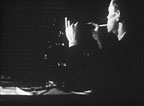 Facts about 16mm Film
Facts about 16mm Film
(“16mm eiga ni tsuite”)- 1950 / Japanese / B&W / Video (Original: 16mm) / 10 min
Source: Tokushima Prefectural Archives
After the war, 16mm films began to gain widespread popularity. This film is something of an instruction manual for the 16mm projector and precautions for its use. That said, the humorous content keeps the viewer engaged, and it is amusing to see the equipment and how it was demonstrated at the beginning of the 1950s. This film will definitely interest you, particularly if you have had any experience projecting 16mm films.
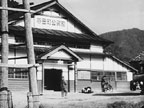 Citizen’s Public Hall
Citizen’s Public Hall
(“Kominkan”)- 1950 / Japanese / B&W / 35mm / 32 min
Production Company: Nihon Eigasha
Source: National Film Center (The National Museum of Modern Art, Tokyo)
A rural town in Fukushima Prefecture, the deep mountains of Hida, a small, remote island in the Seto Inland Sea. . . . The camera crew visits community centers, those symbols of the new era that were established throughout Japan. You’ll find yourself intrigued by the many activities rooted in local spirit, with functions that go beyond assembly halls and local education. Scenes of beauty parlors and bakeries located in community centers reveal little known aspects of the culture of that time.
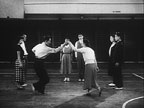 Let’s Square Dance
Let’s Square Dance
(“Square dance o odoro”)- 1950 / Japanese / B&W / 35mm / 14 min
Director, Script: Nibu Tadashi, Mizuki Soya
Photography: Hyuga Kiyomitsu, Takeuchi Mitsuo
Production Company: Tokyo Eiken
Source: National Film Center (The National Museum of Modern Art, Tokyo)
Square dancing, where four couples form a set and trace a square as they dance. This film cheerfully presents the popularity of square dancing in the US, and the sunny gatherings where scores of smiling couples come together to dance. The scenes that teach the basic dance steps display an uncanny freshness. Watch this film and you’ll know how to square dance! Don’t miss it!
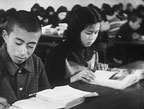 Libraries without Bars
Libraries without Bars
(“Koshi naki toshokan”)- 1950 / Japanese / B&W / 35mm / 22 min
Production Company: Nihon Eigasha
Source: National Film Center (The National Museum of Modern Art, Tokyo)
The Library Law went into effect in 1950. Closed-stack libraries that involved lots of red tape to borrow books are likened to barred prisons, while the film introduces the new functions of libraries opened up to the public. This precious document reveals how libraries, which we take for granted as gathering places and as libraries-on-wheels, were liberated to the public after a tortuous journey.
B
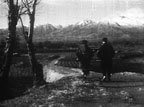 Bent with the Years
Bent with the Years
(“Koshi no magaru hanashi”)- 1949 / Japanese / B&W / Video (Original: 35mm) / 19 min
Director, Script: Kuwano Shigeru, Anbara Shuichi
Photography: Nakamura Seiji
Production Company: Nihon Eigasha
Source: Tokushima Prefectural Archives
This film uses drama to depict women in an agricultural cooperative who strive to improve life in mountainous Shinshu (Nagano). At first the protagonist’s husband ignores the women’s efforts, but gradually he begins to understand their activities. . . . Postwar democratic society will be transformed by women! That passionate cry echoes from the screen.
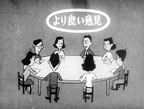 Discussion Techniques
Discussion Techniques
(“Discussion no tebiki”)- 1952 / Japanese / B&W / Video (Original: 35mm) / 23 min
Production Company: Riken Eiga, Nihon Manga Eiga
Source: Tokushima Prefectural Archives
This film introduces various forms of discussion in order to promote democratic debate. Symposiums, buzz sessions, role-playing, and other approaches are shown using real life examples from schools and workplaces, with humorous commentary. The film uses animation for some situations, unusual for a domestically produced CIE film.
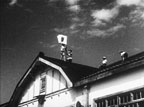 Children’s Guardian
Children’s Guardian
(“Itoshiki kora no tame ni”)- 1950 / Japanese / B&W / Video (Original: 35mm) / 39 min
Cast: Mihashi Ko, Hanazawa Tokue
Production Company: Toho
Source: Tokushima Prefectural Archives
Set at an elementary school, this story depicts the emotions of a custodian and his son, as teachers burning with idealism confront irregularities in the election of the local board of education. A dramatic film that advocates the establishment of democratic education. Mihashi Ko, known for his appearances in Naruse Mikio’s films, plays the custodian, and Hanazawa Tokue plays the local boss underling.
C
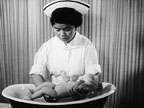 Public Health Nurse
Public Health Nurse
(“Hokenfu no tegami”)- 1951 / Japanese / B&W / Video (Original: 35mm) / 18 min
Production Company: Premier Eiga
Source: Tokushima Prefectural Archives
This film introduces the activities of public health nurses, through the exchange of letters of nursing school friends discussing their work. There is a fascinating contrast between urban areas where nurses visit apartment complexes to teach residents infection prevention, and mountain areas where nurses visit snow-covered homes on skis. The film reflects the US occupation approach to disseminating concepts of hygiene through easy-to-understand instruction.
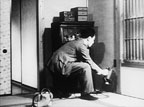 Where Are the Germs?
Where Are the Germs?
(“Byokin wa doko ni aruka”)- 1952 / Japanese / B&W / Video (Original: 35mm) / 18 min
Production Company: Nakai Productions
Source: Tokushima Prefectural Archives
Food sanitation supervisors from a public health center search for and elucidate the cause of food poisoning among children. The film is made so that you learn methods for preventing infection, while enjoying the suspense of watching a detective story unfold. A unique work that gives you a view of hygiene practices during this time.
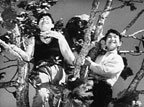 Son of the Earth
Son of the Earth
(“Daichi no ko”)- 1958 / Japanese / B&W / Video (Original: 35mm) / 45 min
Production Company: Nihon Eiga Shinsha
Source: Tokushima Prefectural Archives
A boy, the lead character, follows his father to Hokkaido, where he works on an effort to clear undeveloped land. As he watches his father at work, the boy makes a decision to live on the land. This ficion film carefully records the settlement of Hokkaido just after the war. The monochrome frames brim with the bodies of men at work, hoeing the soil and operating heavy equipment in the desolate territory.
D
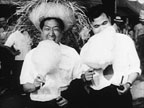 Introduction to America
Introduction to America
(“America e no tebiki”)- 1952 / Japanese, English / B&W / Video (Original: 35mm) / 21 min
Production Company: Frank Donovan Associates
Source: Tokushima Prefectural Archives
This film documents a summer spent at Bard College by Japanese exchange students visiting the US. The students are at first bewildered by cultural differences, but gradually overcome language barriers and open up to exchange students from other countries and engage in discussions. The depiction of the students’ growth gives a glimpse of the American promotion of internationalization at that time.
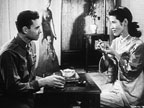 Japanese Bride in America
Japanese Bride in America
(“Senso hanayome”)- 1952 / Japanese / B&W / Video (Original: 35mm) / 30 min
Production Company: Knickerbocker Productions
Source: Tokushima Prefectural Archives
Senso hanayome (“war bride”) was the term used for Japanese women who married men in the US military and moved to the US during the early postwar occupation. This film depicts a Japanese woman, married to a US soldier and living on foreign soil, who overcomes language and cultural barriers and deepens connections through bamboo craftwork and other Japanese cultural activities, to gain acceptance into American society.
 The Cumberland Story
The Cumberland Story
(“Igirisu no tankogyo”)- 1950 / English, Japanese / B&W / Video (Original: 35mm) / 40 min
Director: Humphrey Jennings
Source: Tokushima Prefectural Archives
The story of the development of British undersea mining, based on actual events. The film explains, in the grammar of a feature film, the pioneering efforts to reorganize coal mining, by carefully following the history and the process. The actors are not professionals but the people on site, which gives this film a fascinating sense of reality.
